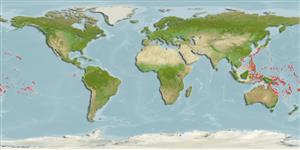Actinopterygii (ray-finned fishes) >
Perciformes (Perch-likes) >
Tripterygiidae (Triplefin blennies) > Tripterygiinae
Etymology: Enneapterygius: Greek, ennea = nine times + Greek, pterygion = little fin (Ref. 45335); nigricauda: Specific name refers to the black caudal fin of the males.. More on author: Fricke.
Environment / Climate / Range
Ecology
Marine; demersal; depth range 0 - 11 m (Ref. 27223). Tropical, preferred ?
Western Central Pacific: Taiwan, Philippines, Vanuatu, Tonga, American Samoa, Society Islands, Kiribati, Jarvis Island, Howland Island, Wake Island, Marshall Islands, Micronesia, Guam, and Boni Islands (Japan).
Size / Weight / Age
Maturity: Lm ? range ? - ? cm
Max length : 2.9 cm SL male/unsexed; (Ref. 27223)
Dorsal
spines
(total): 14 - 17;
Dorsal
soft rays
(total): 7-10;
Anal
spines: 1;
Anal
soft rays: 16 - 19. Male red with darker red, double red bars , black "mask" covering front and lower two-thirds of head, chest, and pectoral-fin base, narrow white bar at caudal-fin base, and basal two-thirds to three-fourths of caudal-fin black. Female translucent greenish grey with indistinct reddish blotches along back, middle of sides, and just above anal-fin base. Head, chest, and pectoral-fin base scaleless; short orbital tentacle present; mandibular pores 3-4 + 1 + 3-4. Maximum size to 3.5 cm TL (Ref. 90102).
Adults are found on seaward and lagoon reefs, usually less than 5 m (Ref. 90102). Eggs are hemispherical and covered with numerous sticky threads that anchor them in the algae on the nesting sites (Ref. 240). Larvae are planktonic which occur primarily in shallow, nearshore waters (Ref. 94114). Minimum depth from Ref. 58018.
Life cycle and mating behavior
Maturity | Reproduction | Spawning | Eggs | Fecundity | Larvae
Fricke, R., 1997. Tripterygiid fishes of the western and central Pacific, with descriptions of 15 new species, including an annotated checklist of world Tripterygiidae (Teleostei). Theses Zool. 29:1-607. (Ref. 27223)
IUCN Red List Status (Ref. 115185)
CITES (Ref. 94142)
Not Evaluated
Threat to humans
Harmless
Human uses
More information
ReferencesAquacultureAquaculture profileStrainsGeneticsAllele frequenciesHeritabilityDiseasesProcessingMass conversion
Tools
Special reports
Download XML
Internet sources
